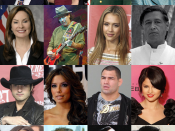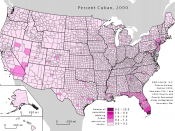While it is true that in the United States Hispanics are grouped together as one race, there are many separate cultures. An immigrant from Brazil does not share the same heritage as one from Mexico. There are as many differences as there are similarities. The writer will illustrate this with four groups of Hispanics.
Dominican-AmericansAs of the year 2000 there were 799,768 Dominicans (immigrants from the Dominican Republic) living in the United States. They account for less than three percent of the Hispanic population. A shrinking job market and political unrest led to immigration to the U.S. Nearly 600,000 settled in the New York City area, making up seven percent of the population. (U.S. Census Bureau, 2000). In fact, some areas of New York City are just like being in the Dominican Republic. People in the Dominican Republic are 16% white, 11% black, and 73% mixed. There is a strong African-American influence.
As for religion, there is a strong Spanish influence as it is 95% Catholic with some Protestant, Voodoo and other religions making up the last five percent. The official language of the Dominican Republic is Spanish, therefore only seven percent of those in the United States use only English at home.
While most Hispanics are likely to lean toward the Democratic Party, Dominicans in the U.S. pay more attention to politics in the Dominican Republic than in the United States. Their literacy rate is 83%, with those having at least a high school education at fifty one percent. Less than eleven percent have a bachelor's degree or higher. The poverty rate is 27.5%. The average Dominican household has four people and most households are family. Less than 16% are non-family households. Of the four groups of Hispanics, here Dominicans have the lowest median family income of $28, 729.


